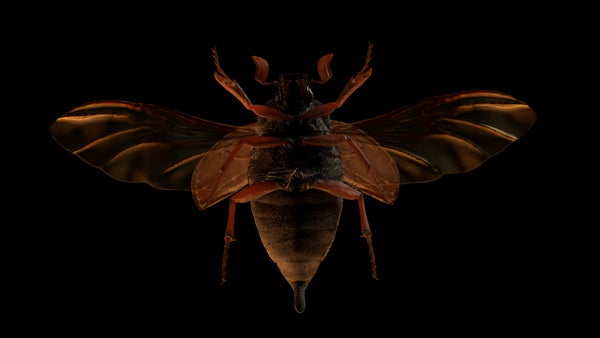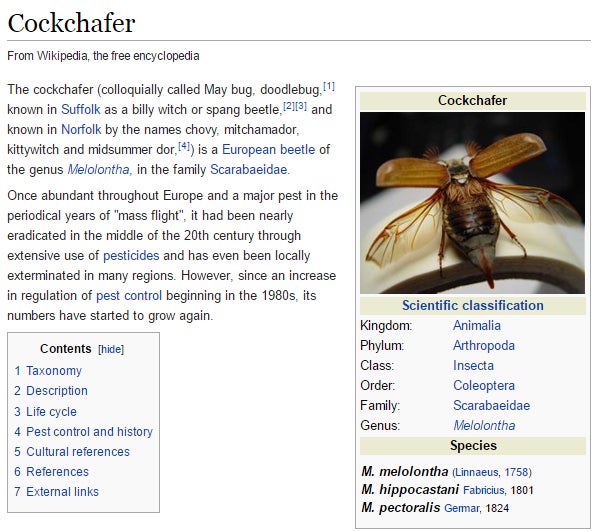This article was published in Scientific American’s former blog network and reflects the views of the author, not necessarily those of Scientific American
The first early hours of the 2nd annual #SciArt Tweet Storm had me pretty nervous. The previous year was such a smashing success: what if no one showed up to the party? What if that one weird crystals-and-pyramids New Age account tweeted a lot of #SciArt-tagged tweets? It didn't occur to me to be worried about porn.

Maybug (M. melolontha, ventral view. 3D digital render © by Mieke Roth, shared during the 2016 #SciArt Tweet Storm.
The #SciArt Tweet Storm is an event the Symbiartic team of Kalliopi, Katie, and myself came up with last year to try and forge connections between scientific illustrators, fine artists, cartoonists, comic artists, dataviz designers, and bioartists, all inspired by science, with the editors, journalists, bloggers, scientists, and science publication art directors who need them. The rules are simple: 1) Tweet 3 pieces of your own sciart per day, 2) retweet 5 from other people, and 3) use the #SciArt hashtag. By inundating Twitter with tons of science-art, hopefully people will find new artists to follow, prints to buy, and maybe even hire. Last year the event generated almost 29,000 tweets, and this year over 21,000.
On supporting science journalism
If you're enjoying this article, consider supporting our award-winning journalism by subscribing. By purchasing a subscription you are helping to ensure the future of impactful stories about the discoveries and ideas shaping our world today.
At 7 am EST on March 1st, I posted the announcement that the #SciArt Tweet Storm was on. After I dropped the kids at school and arrived at work, I checked in with the Storm and was surprised to see an obvious porn bot Twitter account of a woman in lingerie saying "if you want to see the rest of me, click on the link". And the porn bot was using the #SciArt hashtag.
As the next hour rolled on I would glance at the sciart tweets rolling by in Tweetdeck, and about 1-in-10 were porn bots using the hashtag. Artists were commenting on it. I got a message from my co-blogger Katie McKissick and we discussed and nervously laughed about what we could do. I had to close Tweetdeck: as the morning went on, it wasn't just half-naked women anymore. Images of hardcore porn were being tagged with the #SciArt hashtag, too.
So before noon, I took a bit of time to scroll back through several hundred #SciArt tweets to see if I could figure out what was going on.
Then I came across these incredibly lifelike 3D renders by my friend and scientific illustrator, Mieke Roth, @miekeroth, of the Maybug:
The Maybug is as accurate as possible. One of my favorite renditions is this one, from its underside. #Sciart pic.twitter.com/r3PdAxdS8c
— Mieke Roth (@miekeroth) March 1, 2016
Or, as it is also known:

Via Wikipedia, with an inset photo by Mario Sarto.
Mieke Roth's original tweets used the most common name in the U.K. for this beetle: The Cockchafer. Mieke had put a series of tweets showing her 3D anatomical model as part of her participation in the #SciArt Tweet Storm.
I had a strong suspicion this common name for Melolontha melolontha was the source of the problem. By noon, I sent Mieke a direct message about it and she agreed to try deleting her tweets, and putting up replacements (one seen above) with the less common name, "Maybug".
I couldn't believe what happened next. I was hoping it might prevent new porn spambots from latching onto the #sciart hashtag, but by deleting the cockchafer tweets, it did more than that. There were at least two streams of spambots targeting the hashtag, identifiable by the same message being re-shared over and over with different photos from many different accounts: some accounts had the "click on the link for more nude pixxx"-type of message, and the other was, well raunchier, but the same message again and again, from multiple accounts.
Deleting the tweets not only stopped new series of spambots from using the #sciart hashtag, it also stopped the ones already using it. Which I find completely fascinating.
So the next time you're using a community hashtag of any kind, if you suddenly see porn jumping into the convo, don't just assume you've made it, and are so popular even bots are using you as a vector for infection. Instead, take a walk back through the conversation and see if it's possible some other term or keyword has mistakenly attracted the spambots to your community picnic.
And many thanks to Mieke Roth for acting so quickly to help turn this around! Make sure to have a look at her portfolio site, her Sketchfab portfolio, interactive apps, and follow her on Twitter @miekeroth.
Cockchafer Animated WIP by Mieke Roth on Sketchfab
* * * *
I have a further proposal to make.
The #SciArt Tweet Storm is about the community of science artists online finding each other, and making onnections to editors and science bloggers of all kinds. The
Cockcha--er, Maybug tweets by themselves became a kind of lesson in community discussion and managing an online event.
I propose we adopt the Maybug as the official mascot of the #SciArt Tweet Storm. What say you?